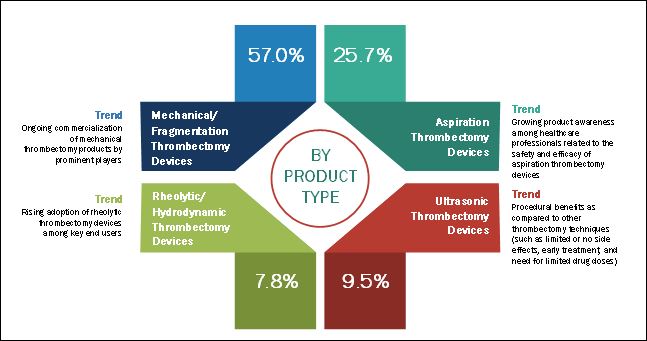Thrombectomy Devices Market - Growth Opportunities | Industry Report 2022
Factors such as increasing prevalence of cardiovascular diseases across
major markets, procedural benefits offered by mechanical thrombectomy in
cardiac surgeries, higher prevalence of thrombotic diseases among
geriatric individuals, and growing preference of surgeons for
image-guided and minimally invasive cardiac surgeries.
According to research report the global thrombectomy devices market is estimated to reach USD 1.45 billion by 2022; growing at a CAGR of 6.7% during the forecast period.
Download Brochure: https://www.marketsandmarkets.com/pdfdownloadNew.asp?id=222966801
In this report, the market has been segmented by type, application, end user, and region.
In 2016, North America held the largest share of the market
• Based on application, the market is segmented into cardiovascular, neurovascular, and peripheral vascular applications. Peripheral vascular segment is expected to be the fastest growing in the market during the forecast period. This growth can be attributed to the rising availability of medical reimbursements for peripheral thrombectomy procedures across major markets, rising incidence of vascular disorders across the globe, growing geriatric population, ongoing technological advancements in the field of vascular ultrasound treatment, and rising awareness related to clinical efficacy of thrombectomy procedures in PVD treatment.
• Based on type, the market is segmented into aspiration, mechanical, rheolytic, and ultrasonic thrombectomy devices. The ultrasonic thrombectomy devices segment is poised to be the fastest growing during the forecast period. The growing demand for ultrasonic thrombectomy devices can primarily be attributed to factors such as rising adoption of ultrasonic thrombectomy products by medical professionals, higher therapeutic efficacy for the treatment of deep vein thrombosis and pulmonary embolism, and its affordability.
• By end user, the market is segmented into hospitals & surgical centres, ambulatory surgical centres, research laboratories & academic institutes, and other end users. Ambulatory surgical centres (ASCs) are expected to be the fastest growing end user segment in the market. This high growth can be attributed to the increasing availability of reimbursement for thrombectomy procedures in outpatient settings, ongoing advancements in minimally invasive surgical techniques, increasing number of image-guided surgeries performed at ASCs, and rising market demand for miniaturized therapeutic devices.
Get Report Sample: https://www.marketsandmarkets.com/requestsampleNew.asp?id=222966801
In 2016, Stryker Corporation (U.S.) held the leading position in the Thrombectomy Devices Market. Over the past three years, the company has adopted product launches & enhancements, strategic acquisitions, and market expansion as its key business strategies to ensure its dominance in this market. Medtronic plc (Ireland), Boston Scientific Corporation (U.S.), Johnson & Johnson (U.S.), Terumo Corporation (Japan), Penumbra, Inc. (U.S.), Spectranetics Corporation (U.S.), Edwards Lifesciences Corporation (U.S.), Argon Medical Devices, Inc. (U.S.), and Teleflex Incorporated (U.S.), were few other key players operating in the market.
According to research report the global thrombectomy devices market is estimated to reach USD 1.45 billion by 2022; growing at a CAGR of 6.7% during the forecast period.
Download Brochure: https://www.marketsandmarkets.com/pdfdownloadNew.asp?id=222966801
In this report, the market has been segmented by type, application, end user, and region.
In 2016, North America held the largest share of the market
• Based on application, the market is segmented into cardiovascular, neurovascular, and peripheral vascular applications. Peripheral vascular segment is expected to be the fastest growing in the market during the forecast period. This growth can be attributed to the rising availability of medical reimbursements for peripheral thrombectomy procedures across major markets, rising incidence of vascular disorders across the globe, growing geriatric population, ongoing technological advancements in the field of vascular ultrasound treatment, and rising awareness related to clinical efficacy of thrombectomy procedures in PVD treatment.
• Based on type, the market is segmented into aspiration, mechanical, rheolytic, and ultrasonic thrombectomy devices. The ultrasonic thrombectomy devices segment is poised to be the fastest growing during the forecast period. The growing demand for ultrasonic thrombectomy devices can primarily be attributed to factors such as rising adoption of ultrasonic thrombectomy products by medical professionals, higher therapeutic efficacy for the treatment of deep vein thrombosis and pulmonary embolism, and its affordability.
• By end user, the market is segmented into hospitals & surgical centres, ambulatory surgical centres, research laboratories & academic institutes, and other end users. Ambulatory surgical centres (ASCs) are expected to be the fastest growing end user segment in the market. This high growth can be attributed to the increasing availability of reimbursement for thrombectomy procedures in outpatient settings, ongoing advancements in minimally invasive surgical techniques, increasing number of image-guided surgeries performed at ASCs, and rising market demand for miniaturized therapeutic devices.
Get Report Sample: https://www.marketsandmarkets.com/requestsampleNew.asp?id=222966801
In 2016, Stryker Corporation (U.S.) held the leading position in the Thrombectomy Devices Market. Over the past three years, the company has adopted product launches & enhancements, strategic acquisitions, and market expansion as its key business strategies to ensure its dominance in this market. Medtronic plc (Ireland), Boston Scientific Corporation (U.S.), Johnson & Johnson (U.S.), Terumo Corporation (Japan), Penumbra, Inc. (U.S.), Spectranetics Corporation (U.S.), Edwards Lifesciences Corporation (U.S.), Argon Medical Devices, Inc. (U.S.), and Teleflex Incorporated (U.S.), were few other key players operating in the market.

Comments
Post a Comment